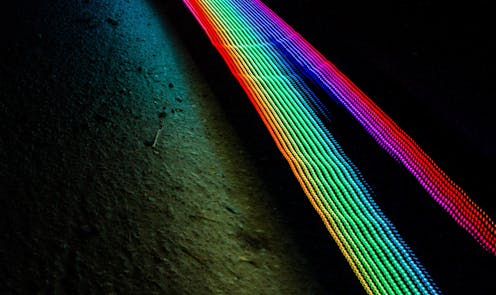Famous double-slit experiment recreated in fourth dimension by physicists
- Written by Stefan Maier, Head of School of Physics and Astronomy, Monash University

More than 200 years ago, the English scientist Thomas Young carried out a famous test known as the “double-slit experiment[1]”. He shone a beam of light at a screen with two slits in it, and observed the light that passed through the apertures formed a pattern of dark and bright bands.
At the time, the experiment was understood to demonstrate that light was a wave. The “interference pattern” is caused by light waves passing through both slits and interfering with each other on the other side, producing bright bands where the peaks of the two waves line up and dark bands where a peak meets a trough and the two cancel out.
In the 20th century, physicists realised the experiment could be adapted to demonstrate that light not only behaves like a wave, but also like a particle (called a photon). In quantum mechanical theory, this particle still has wave properties – so the wave associated with even a single photon passes through both slits, and creates interference.
In a new twist on the classic experiment, we replaced the slits in the screen with “slits” in time – and discovered a new kind of interference pattern. Our results are published today[2] in Nature Physics.
Slits in time
Our team, led by Riccardo Sapienza at Imperial College London, fired light through a material that changes its properties in femtoseconds (quadrillionths of a second), only allowing light to pass through at specific times in quick succession.
We still saw interference patterns – but instead of showing up as bands of bright and dark, they showed up as changes in the frequency or colour of the beams of light.
Read more: Curious Kids: is light a wave or a particle?[3]
To carry out our experiment, we devised a way to switch on and off the reflectivity of a screen incredibly quickly. We had a transparent screen that became a mirror for two brief instants, creating the equivalent of two slits in time.
Colour interference
So what do these slits in time do to light? If we think of light as a particle, a photon sent at this screen might be reflected by the first increase of reflectivity or by the second, and reach a detector.
However, the wave nature of the process means the photon is in a sense reflected by both temporal slits. This creates interference, and a varying pattern of colour in the light that reaches the detector.
Read more: Explainer: what is wave-particle duality[4]
The amount of change in colour is related to how fast the mirror changes its reflectivity. These changes must be on timescales comparable with the length of a single cycle of a light-wave, which is measured in femtoseconds.
Electronic devices cannot function quickly enough for this. So we had to use light to switch on and off the reflectivity of our screen.
We took a screen of indium tin oxide, a transparent material used in mobile phone screens, and made it reflective with a brief pulse of laser light.
From space to time
Our experiment is a beautiful demonstration of wave physics, and also shows how we can transfer concepts such as interference from the domain of space to the domain of time.
The experiment has also helped us in understanding materials that can minutely control the behaviour of light in space and time. This will have applications in signal processing and perhaps even light-powered computers.
References
- ^ double-slit experiment (royalsocietypublishing.org)
- ^ published today (www.nature.com)
- ^ Curious Kids: is light a wave or a particle? (theconversation.com)
- ^ Explainer: what is wave-particle duality (theconversation.com)

















